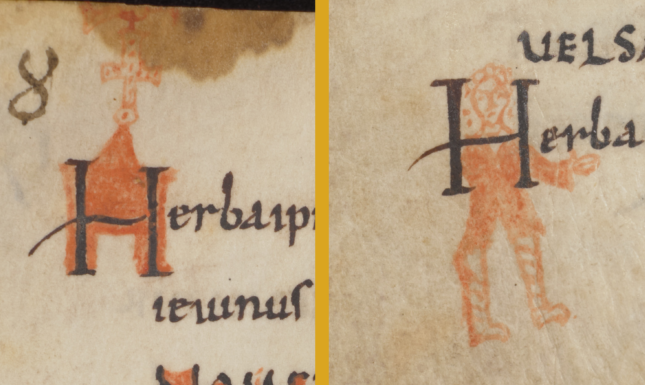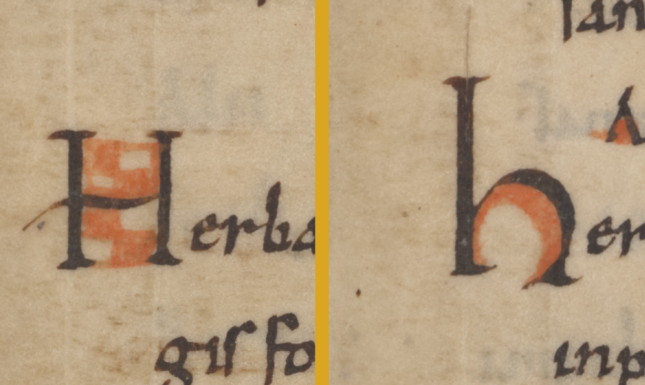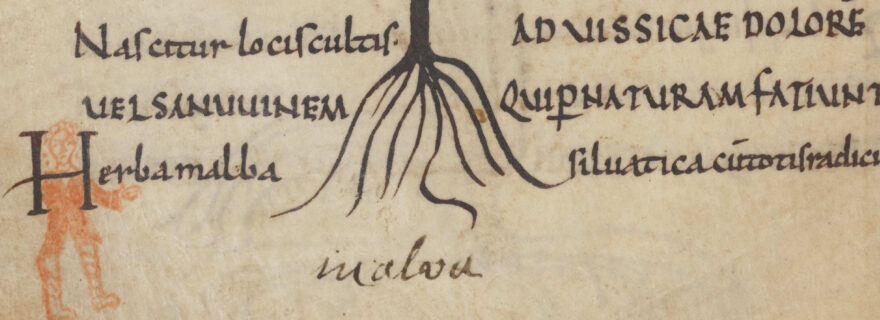A new reading of medieval ‘doodles’
Doodles in medieval manuscripts are often interpreted as idle and mindless scribbles. But is this an accurate assessment? Could doodles instead reveal a hitherto unexplored way that people in the Middle Ages interacted with their manuscripts?
Within the archives of Het Huis van het Boek in The Hague lies a manuscript with intriguing markings. This manuscript known as MMW 10 D 7, a tenth-century Latin text produced in France on the medical and toxic properties of plants and animals, has two of its pages adorned with red drawings. These markings differ from those that normally decorate medieval manuscripts – illustrations made with deliberate care and planning, meant to adorn and add meaning to the text. As such, these and other seemingly mindless and idle drawings have been interpreted as ‘doodles’. But using the term doodle when describing medieval markings on parchment is problematic. The concept carries modern connotations and is used in a twenty-first-century world with a reading and writing culture vastly different from that of the Middle Ages. The word evokes an image of a bored reader passing idle time by letting their imagination wander across the parchment. However, a closer examination of the markings in the manuscript suggests that more is going on than just the casual sketches of a bored mind. Do we need to reconsider our interpretation of the concept of doodles when applied to medieval manuscripts, and might a new reading of medieval doodling perhaps reveal a hitherto unknown way that people in the Middle Ages interacted with their manuscripts?


Doodling in the Middle Ages
Medieval manuscripts carry an extraordinary amount of information with them. They were part of a circular economy, being passed on, shared, reused, and repaired throughout their lifecycle. Every time the manuscript changed hands, another piece of history was imprinted onto the pages. These imprints include annotations, comments, drawings, and glued-on or sewn-in pieces of parchments. By looking closely at the different marks left on the parchment, different types of medieval user interactions can be discovered.
One controversial type of imprint involves markings that some scholars interpret as doodles. There are four theories that explain the presence of doodles within manuscripts. One interpretation states that the doodles were pen trials. Medieval pens were typically made from feathers that, contrary to our modern pens, regularly needed to be trimmed and resharpened: a dull writing instrument was of no use to a diligent scribe. To make sure the pen had obtained the right sharpness, it was tested on a piece of parchment or in the margins of a page. As is visible in figures 1 and 2, pen trials are very recognisable by their repeating strokes, lines, and swirls and repetitive letters and words (Kwakkel 2018; Killacky 2022).




Doodles might also be interpreted as a commentary on the text. Examples include annotations, signs, or manicules (small hands), which we often encounter in the margins or between lines of text. These specific markings were used to contradict, parody, support, or comment on the meaning of the text. Figure three shows examples of such commentaries. For doodles to be interpreted as commentaries, however, they must interact closely with the contents of the text. For some markings, this does not seem to be the case (Rudy 2016, 75; Camille 1992, 7).
If neither of these two explanations holds true, doodles are sometimes classified as children’s drawings. This theory is frequently supported by studies that compare children’s brain development with their ability, or lack thereof, to draw different types of images (Thrope 2016). See, for example, figure 4. More often, however, doodles are dismissed as children's drawings simply because no better explanation for their presence can be found. In other cases, when doodles are attributed to adults, they are seen as idle fruits of time and thus brushed off as mindless or even useless pen scribbles (Dean 2009).


These last two explanations have received significant criticism. Scholars like Erik Kwakkel argue that medieval doodling is neither the result of boredom nor of absent-minded pen strokes; rather, it is a deliberate and calculated action executed with a specific goal in mind (Kwakkel 2018). By closely examining the markings on the parchment, I argue that the doodles in MMW 10 D 7 are also the result of deliberate and purposeful action. In fact, by recognising them as calculated products, we can uncover a hitherto unknown type of medieval manuscript user interaction.
‘Doodles’ in manuscript MMW 10 D 7


In MMW 10 D 7, on folios 9v and 10r, several markings were made with red ink. Looking at figures 5 and 6, in the top left corner of the folio we can see that the letter ‘H’ has been transformed into a church-like structure. A triangle at the top serves as the roof, while the rest of the letter is filled in with red. Below the horizontal bar of the 'H', a gap is left, suggesting an entrance with open doors. In particular, the cross at the tip of the triangle, possibly depicting a weather vane in the shape of a rooster, further reinforces its church-like appearance.


In the bottom-left corner of the same page, another capital letter is decorated. The drawing depicts a person. The head and neck were probably drawn first as they fit neatly into the upper part of the letter ‘H’. The top section is cut off from the rest of the body by the horizontal bar, with the torso, legs, and one arm drawn below it. This drawing resembles an incipit letter, a common feature in medieval manuscripts where the first letter of a sentence or text is decorated with drawings of objects, animals, or people. However, with incipits the letter and its embellishments are drawn simultaneously and planned in advance. The red markings in MMW 10 D 7, on the other hand, appear to have been added at a later stage.


In figure 7, we can see two more decorated letters. In one, a checkerboard-like pattern is drawn within the boundaries of the capital letter 'H' (see details in figure 8). Unlike the drawings on folio 9v, these markings do not depict any recognisable image or figure. The same is true for the lowercase ‘h’ on the same page. Here, the red ink follows the curvature of the letter’s arc but leaves the vertical line untouched.


On both folios 9v and 10r, markings were also added to smaller letters: here the artist traced the curves, corners, lines and openings of the letters, selectively and deliberately filing in certain spaces and leaving others untouched. However, apart from the doodles decorating the letters and text, no other parts of the parchment were touched with red ink. The floral and plant drawings are left unmarked, as are the margins and other empty spaces on the pages: only the letters were selected for decoration.
A new type of user interaction
Do the markings in MMW 10 D 7 lead us to reconsider our understanding of the concept of medieval doodles? I believe they do. These markings do not resemble pen trials; nor do they contradict, parody, support, or comment on the text to the extent that commentaries do. Are these doodles then idle and mindless scribbles? No, a close analyse of the doodles reveals that they were the result of purposeful and calculated actions of the pen. The doodles deliberately and closely interact with the ink already present on the page, using the spatial layout, boundaries, placement and orientation of the letters on the parchment to create something new. As such, an ‘H’ might be transformed into a church-like building; serve as the backdrop of a human figure or become a checkerboard. By giving a new interpretation to letters on the page, medieval doodlers added new layers of meaning to the manuscript, turning these documents into a palimpsest of different interpretations that accumulated over the centuries.
The doodles in MMW 10 D 7 are thus not meaningless expression of an uninterested and bored reader, but the result of purposeful action. Furthermore, the red markings demonstrate that users of manuscripts could engaged with the parchment surface in various ways. By acknowledging and recognising this type of medieval user interaction, we can better understand how people in the Middle Ages read, used and engaged with the manuscripts at the tip of their ink pen.
Further reading:
The primary source used in this blog is The Hague, Huis van het Boek: MMW 10 D 7. The manuscript can be viewed in full here.
Camille, M. Image on the Edge: The Margins of Medieval Art, 1992.
Dean, C. ‘Beyond Prescription: Notarial Doodles and Other Marks’. Word & Image 25:3 (2009): 293–316.
Killacky, M.S. ‘Why so Many Medieval Manuscripts Feature Doodles – and What They Reveal’. The Conversation, 6 October 2022.
Kwakkel, E. ‘Doodles in Medieval Manuscripts’. Medievalbooks, 5 October 2018.
Rudy, K.M. Piety in Pieces: How Medieval Readers Customized Their Manuscripts, 2016.
Thorpe, D.E. ‘Young Hands, Old Books: Drawings by Children in a Fourteenth-Century Manuscript, LJS MS. 361’. Cogent Arts & Humanities, no. 3:1 (2016): 1–18.
Curious about practices of doodling in medieval manuscripts? Check out Erik Kwakkel's LMB post on Doodling in the Middle Ages and Irene O'Daly's blog on how 'cartoons' in manuscripts can add to a text.
© Nina Witteman and Leiden Medievalists Blog, 2024. Unauthorised use and/or duplication of this material without express and written permission from this site’s author and/or owner is strictly prohibited. Excerpts and links may be used, provided that full and clear credit is given to Nina Witteman and Leiden Medievalists Blog with appropriate and specific direction to the original content.


